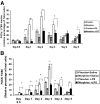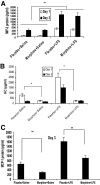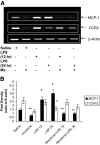Chronic morphine administration delays wound healing by inhibiting immune cell recruitment to the wound site
- PMID: 20042674
- PMCID: PMC2808085
- DOI: 10.2353/ajpath.2010.090457
Chronic morphine administration delays wound healing by inhibiting immune cell recruitment to the wound site
Abstract
Patients prescribed morphine for the management of chronic pain, and chronic heroin abusers, often present with complications such as increased susceptibility to opportunistic infections and inadequate healing of wounds. We investigated the effect of morphine on wound-healing events in the presence of an infection in an in vivo murine model that mimics the clinical manifestations seen in opioid user and abuser populations. We show for the first time that in the presence of an inflammatory inducer, lipopolysaccharide, chronic morphine treatment results in a marked decrease in wound closure, compromised wound integrity, and increased bacterial sepsis. Morphine treatment resulted in a significant delay and reduction in both neutrophil and macrophage recruitment to the wound site. The delay and reduction in neutrophil reduction was attributed to altered early expression of keratinocyte derived cytokine and was independent of macrophage inflammatory protein 2 expression, whereas suppression of macrophage infiltration was attributed to suppressed levels of the potent macrophage chemoattractant monocyte chemotactic protein-1. When the effects of chronic morphine on later wound healing events were investigated, a significant suppression in angiogenesis and myofibroblast recruitment were observed in animals that received chronic morphine administration. Taken together, our findings indicate that morphine treatment results in a delay in the recruitment of cellular events following wounding, resulting in a lack of bacterial clearance and delayed wound closure.
Figures








Similar articles
-
Chronic morphine treatment inhibits LPS-induced angiogenesis: implications in wound healing.Cell Immunol. 2010;265(2):139-45. doi: 10.1016/j.cellimm.2010.08.002. Epub 2010 Aug 14. Cell Immunol. 2010. PMID: 20843508 Free PMC article.
-
Morphine-induced early delays in wound closure: involvement of sensory neuropeptides and modification of neurokinin receptor expression.Biochem Pharmacol. 2009 Jun 1;77(11):1747-55. doi: 10.1016/j.bcp.2009.03.003. Epub 2009 Mar 14. Biochem Pharmacol. 2009. PMID: 19428329 Free PMC article.
-
Episodic binge ethanol exposure impairs murine macrophage infiltration and delays wound closure by promoting defects in early innate immune responses.Alcohol Clin Exp Res. 2014 May;38(5):1347-55. doi: 10.1111/acer.12369. Epub 2014 Apr 1. Alcohol Clin Exp Res. 2014. PMID: 24689549 Free PMC article.
-
Can morphine interfere in the healing process during chronic stress?Arch Dermatol Res. 2012 Aug;304(6):413-20. doi: 10.1007/s00403-012-1261-1. Epub 2012 Jul 7. Arch Dermatol Res. 2012. PMID: 22773134 Review.
-
Should topical opioid analgesics be regarded as effective and safe when applied to chronic cutaneous lesions?J Pharm Pharmacol. 2011 Jun;63(6):747-56. doi: 10.1111/j.2042-7158.2011.01252.x. Epub 2011 May 3. J Pharm Pharmacol. 2011. PMID: 21585371 Review.
Cited by
-
Buprenorphine blunts inflammatory response and wound progression after skin exposure to nitrogen mustard.Wound Repair Regen. 2025 Mar-Apr;33(2):e70009. doi: 10.1111/wrr.70009. Wound Repair Regen. 2025. PMID: 40022640 Free PMC article.
-
Expert consensus on the prevention and treatment of radiochemotherapy-induced oral mucositis.Int J Oral Sci. 2025 Jul 15;17(1):54. doi: 10.1038/s41368-025-00382-8. Int J Oral Sci. 2025. PMID: 40664676 Free PMC article.
-
Severe pain during wound care procedures: A cross-sectional study protocol.J Adv Nurs. 2018 May 7:10.1111/jan.13699. doi: 10.1111/jan.13699. Online ahead of print. J Adv Nurs. 2018. PMID: 29733454 Free PMC article.
-
Effect of opium dependency on secondary intention wound healing in a rat model: an experimental study.Int Wound J. 2013 Jun;10(3):351-5. doi: 10.1111/j.1742-481X.2012.00990.x. Epub 2012 May 28. Int Wound J. 2013. PMID: 22630611 Free PMC article.
-
Grade IV Sacral Sore Treated with an Ointment Rich in PUFAs, Ceramides, and Antimicrobial Peptides.Case Rep Dermatol Med. 2022 Mar 7;2022:4445055. doi: 10.1155/2022/4445055. eCollection 2022. Case Rep Dermatol Med. 2022. PMID: 35295787 Free PMC article.
References
-
- Abbadie C, Pan YX, Pasternak GW. Immunohistochemical study of the expression of exon11-containing mu opioid receptor variants in mouse brain. Neuroscience. 2004;127:419–430. - PubMed
-
- Peckys D, Landwehrmeyer GB. Expression of mu, kappa, and delta opioid receptor messenger RNA in the human CNS: a 33P in situ hybridization study. Neuroscience. 1999;88(4):1093–135. - PubMed
-
- Zastawny RL, George SR, Nguyen T, Cheng R, Tsatsos J, Briones-Urbina R, O'Dowd BF. Cloning, characterization, and distribution of a mu-opioid receptor in rat brain. J Neurochem. 1994;62:2099–2105. - PubMed
-
- Börner C, Stumm R, Höllt V, Kraus J. Comparative analysis of mu-opioid receptor expression in immune and neuronal cells. J Neuroimmunol. 2007;188:56–63. - PubMed
-
- Chuang TK, Killam KF, Jr, Chuang LF, Kung HF, Sheng WS, Chao CC, Yu L, Chuang RY. Mu opioid receptor gene expression in immune cells. Biochem Biophys Res Commun. 1995;216:922–930. - PubMed
Publication types
MeSH terms
Substances
Grants and funding
LinkOut - more resources
Full Text Sources
Medical
Molecular Biology Databases
Research Materials

